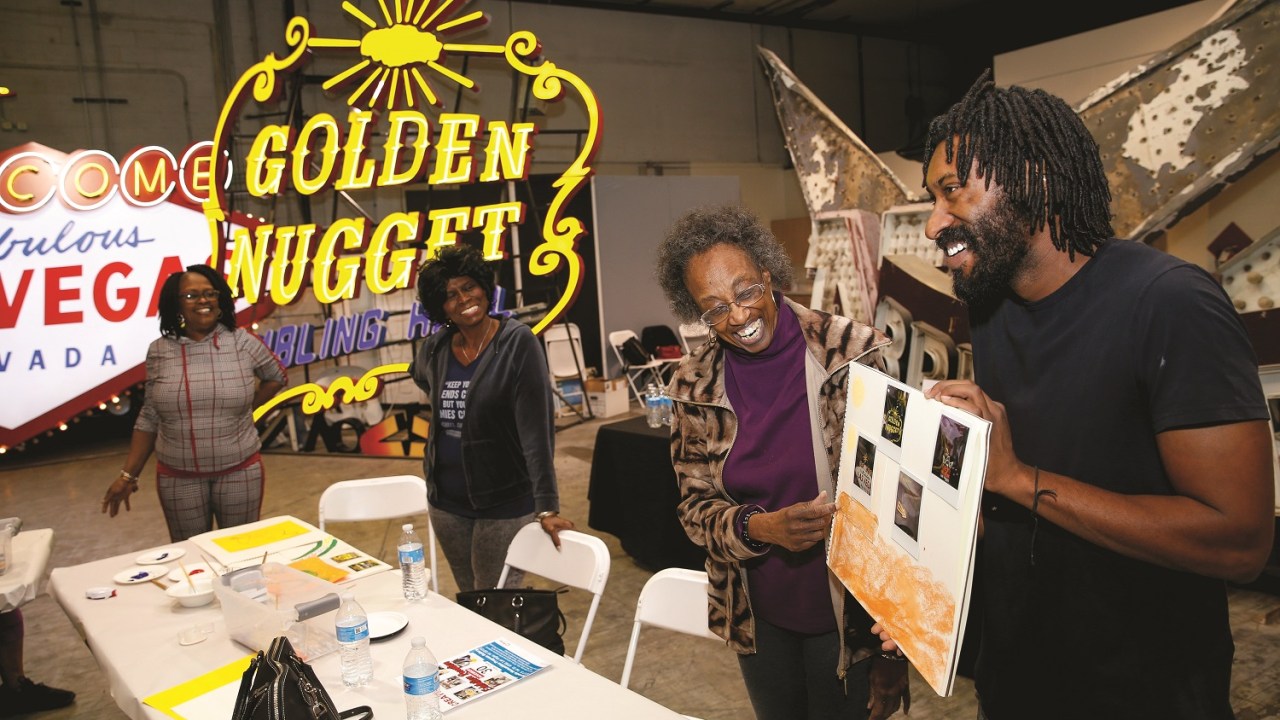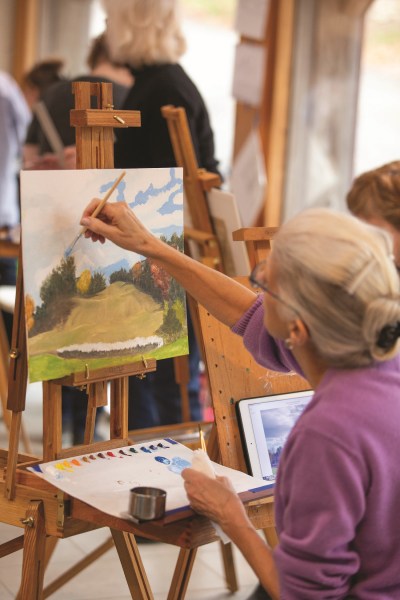
I began thinking about becoming “old” in my mid-40s when I was a caregiver for my energetic, intelligent, and creative aunt. Over the course of 10 years, while I was working in the K–12 arts education arena and raising a family, I moved her (then in her mid-80s) from her apartment in New York City to independent living, then assisted living, then to a memory care unit, and eventually to a skilled nursing facility.

During this time, I witnessed very few moments where she expressed true joy or exhibited a sense of belonging or purpose. I began to think about my own old age and what I could do to help preserve vitality. This is the moment when I connected the aging process with what I knew about the benefits of arts education.
Creative aging programs honor older adults as creative and social learners and help shift the narrative about growing older away from a negative view to one of optimism, engagement in community, and joy.
Creative aging was in its infancy back in the early 2000s, with only small pockets of activity—no real infrastructure, no professional networks, no training. My colleague Ed Friedman, a fellow veteran arts administrator, and I recognized that few organizations offered arts programs for older adults beyond passive entertainment or one-off events. We saw that they needed help to design, fund, and sustain arts education programs specifically aimed at older adults.
When Dr. Gene Cohen’s Creativity and Aging Study was published in 2006, it provided the ballast that we needed to launch Lifetime Arts. Essentially, Cohen’s research demonstrated that skills-based arts learning, in a socially supportive environment, yielded multiple benefits for older learners—not the least of which was its intrinsic value in reducing social isolation. He proved what we arts administrators have always known: the arts are good for you.
Who Are We Calling “Older Adults”?
For older adults contending with social isolation, these arts education programs build community and create new social connections. At Lifetime Arts, we use the term “older adults” to describe folks aged 55 and better. This term—as opposed to “seniors” or “elderly”—is broader and more inclusive, and it is often preferred by the participants themselves.
The Pew Research Center estimates that by 2035 there will be more people over the age of 65 than children under 17. With the population aging at an unprecedented rate, this demographic shift is not just a blip, but a permanent change in the makeup of the world population. Creative aging programs focus on adults 55–100 who are otherwise diverse in every way possible: race, ethnicity, gender, sexual orientation, religion, economic status, access to technology, geographic location, and population density.
This multigenerational 50-year span includes everyone from people who finally have time to follow creative pursuits to retirees experiencing isolation after their built-in social network dissipates. It also includes empty nesters and those whose familial relationships have shifted due to relocation or loss. It includes people with and without partners, and the many people who are living into their 80s and 90s.
Yet, most of us still categorize older adults as “other”—some alien group. No one is out of the “Aging Club.” If you are alive, you are a member. As activist Ashton Applewhite says, “We are all aging, so ageism is actually a prejudice against our future selves.”
The Lifetime Arts Approach
Meeting Lifetime Arts’ overarching goal to enhance the lives of older adults through arts education requires nothing less than facilitating a cultural shift around how community organizations serve older adults. Our work is centered on building individual and institutional capacity to design, deliver, and sustain meaningful creative aging programming. Through our training, coaching, technical assistance, and resources, we offer practical support through a positive, modern, and social lens.
We positioned ourselves as a service organization because we knew early on that embracing older adults as creative learners is a challenge for all types of organizations. We have witnessed ageism at work at every level of engagement and so we include significant training around implicit ageism and its impact on program design and delivery. We aim for institutional/system-level partnerships that can affect and sustain change locally and at scale, building capacity from the top down and the bottom up.
Whether working with an arts, cultural, or senior service organization, we find that programmers and funders need to understand the cognitive, social, and emotional facets of aging and the efficacy of arts education programming in supporting positive aging. They need a replicable, scalable model to develop programs that reflect new scholarship on aging; qualified arts partners to facilitate programming; training to help them initiate, implement, and sustain this very new approach to “senior” programs; and a network of supportive peers who share their mission and can help communicate the value of creative aging activities. Teaching artists who are interested and/or experienced in working with older adults need guidance to help them adapt their curricula and their delivery for older adults—and they need information on how to navigate the world of senior service.
The creative aging model that we promote is based on best practices in arts education; the work is student centered, participatory, sequential and skills-based. The added ingredient of intentional social engagement is what differentiates this model from other adult programs. We’ve learned that older adults are serious about what they choose to study and how they want to learn. They come to the learning with personal goals and practical objectives. They bring with them decades of life experience, which enriches their work. When offered thoughtful, well-designed learning programs, these new arts learners gain confidence, create new and lasting friendships, and often renew their dedication to the host organization.
Strategic Considerations for Museums
For cultural organizations like museums, creative aging extends their reach; advances their educational, cultural, and social missions; builds new community partnerships; and creates new funding streams. With AAM’s involvement, many museums are enthusiastically joining the creative aging movement and contributing to its growth with innovative programming that others can learn from. (Visit aam-us.org/category/creative-aging to read about a few such programs.)
Museums have an opportunity and an obligation to realign their programs and services to address the needs and interests of today’s older adults. How museums respond to this challenge will determine to what extent they thrive in this new reality. Following are two tips on how to achieve success.
Build toward institutionalization by looking beyond the grant. Integrating creative aging programs into your museum’s menu of services should trigger an examination of the impact that this new programming will have on organizational resources—staffing, facilities, budget, leadership. This should include evaluating how resources are allocated for current programs. Do certain long-standing programs need to be maintained in light of shifting goals or a changing patron base? Can resources be allocated more effectively? Are your proposed programs responsive to your community? Are they a natural extension of your primary work? Does the programming leverage your assets? Is there support from the board? From senior leadership?
Pursue cross-sector and multilevel partnerships to build, fund, and sustain successful creative aging programming. Multiple federal, state, and local agencies and organizations count older adults as constituents deserving of focused, responsive service and support. Program providers in the arts, health, aging, veterans, and parks and recreation sectors, as well as public-private partnerships, have the potential to collectively impact the quality of older adults’ lives in America. Creative aging programming is furnishing a fertile field for these collaborations to grow. Current Lifetime Arts partnerships include the Brooklyn Public Library and New York Community Trust, Wyoming State Library and Wyoming Arts Council, Idaho Commission on the Arts and Idaho Division of Veterans Services, New York State Council on the Arts, New York State Office for the Aging and Area Agencies on Aging, National Assembly of State Arts Agencies, Aroha Philanthropies, and many more.
The work we all do together to improve the lives of older adults through creative aging is making a positive difference on multiple levels. It is not only transforming and enriching the lives of individuals who participate in arts education workshops, but also motivating organizations to take a fresh look at how best to engage all learners in meaningful and beneficial ways. American museums of every size and type are welcomed partners.
Questions for Museum Teams to Consider
How might you think about older adults differently?
Who in your museum is charged with thinking about/serving older adults?
What educational programs do you offer? To whom?
Who are your community partners?
How are your educational programs funded?
What do you know about what older adults want from your museum?
Do you provide programs outside of the museum? In the community?
What is your current approach toward multigenerational programming?
Resources
Lifetime Arts lifetimearts.org
AAM Creative Aging page aam-us.org/category/creative-aging/
The Creative Aging Resource creativeagingresource.org







